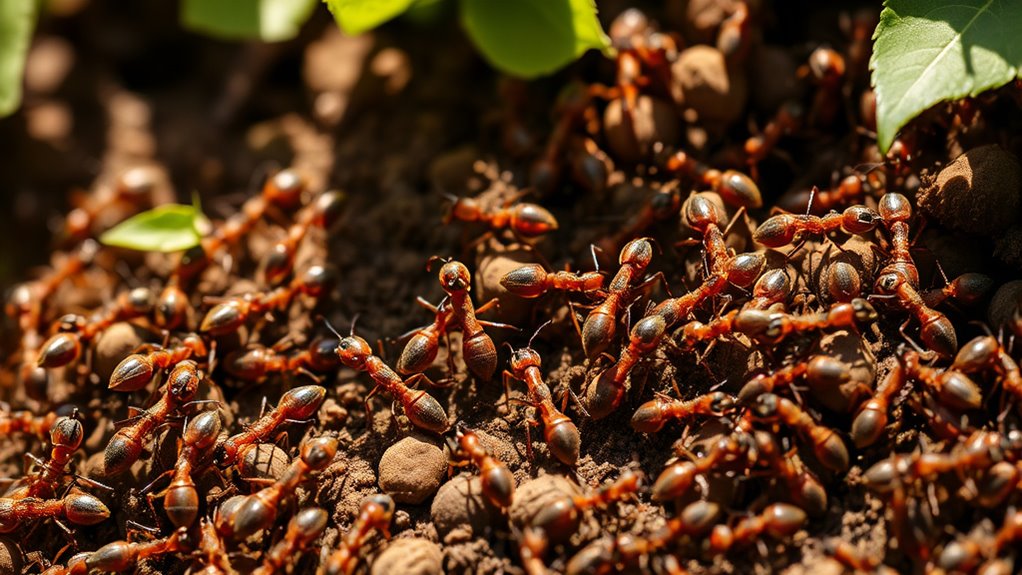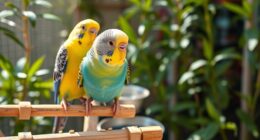Ant colonies show incredible teamwork through clear roles, effective communication, and collaborative efforts. Each ant, from the queen to workers, has designated tasks that enhance productivity and accountability. They use pheromones to guide and alert each other, fostering efficient resource management. Their ability to adapt and work together strengthens the colony's resilience. You'll discover how these remarkable behaviors not only sustain their ecosystem but can also inspire human teamwork in various contexts.
Key Takeaways
- Ant colonies exhibit clear role differentiation, with queens, workers, and drones each contributing to the colony's productivity and success.
- Communication through pheromones and sounds allows ants to collaborate effectively, guiding foraging and alerting to threats.
- Collective resilience and adaptability among ants enhance their survival, showcasing the power of unity in overcoming challenges.
- Ants significantly impact ecosystems by aerating soil, controlling pests, and promoting biodiversity, highlighting their ecological role.
- Human teams can learn from ant behaviors, fostering cooperation, efficient resource management, and innovative solutions in various industries.
Understanding Ant Colonies and Their Structure
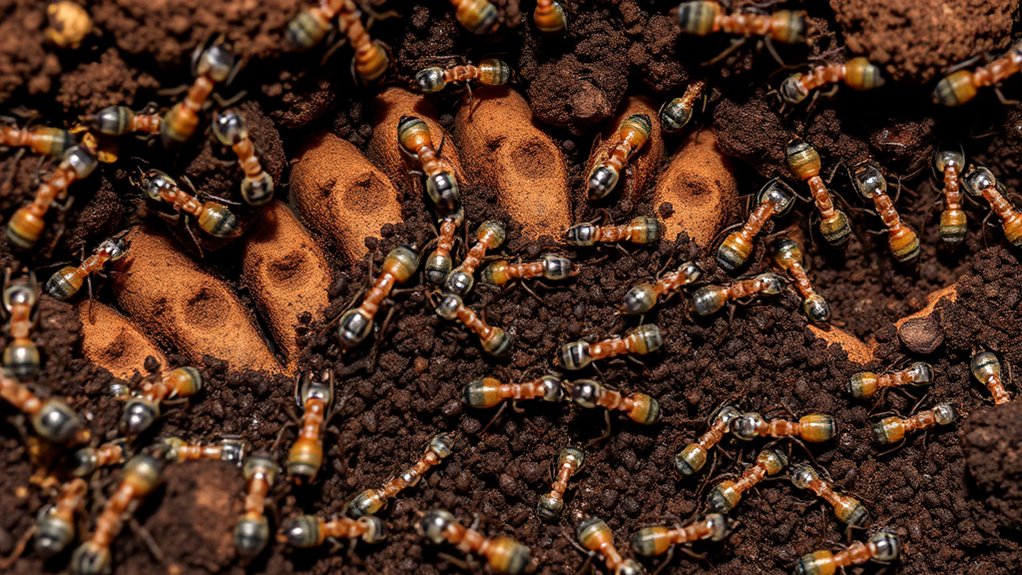
Ant colonies function as complex societies, primarily led by one or more queen ants. The queen's main role is to reproduce, laying up to 30,000 eggs daily, ensuring the colony's growth.
Worker ants, usually female and often sisters, tackle essential tasks like foraging for food, digging tunnels, and caring for the brood. Male drones exist solely to mate with the queen, playing a secondary role in the colony's structure.
With overlapping generations, first-generation workers rely on the queen's eggs until they mature and can contribute to foraging.
Ants communicate through pheromones and sounds, coordinating their activities to maintain the colony's efficiency. This organized system, featuring diverse roles like workers and soldiers, enables the ant colony to thrive and adapt.
The Importance of Defined Roles in Teamwork
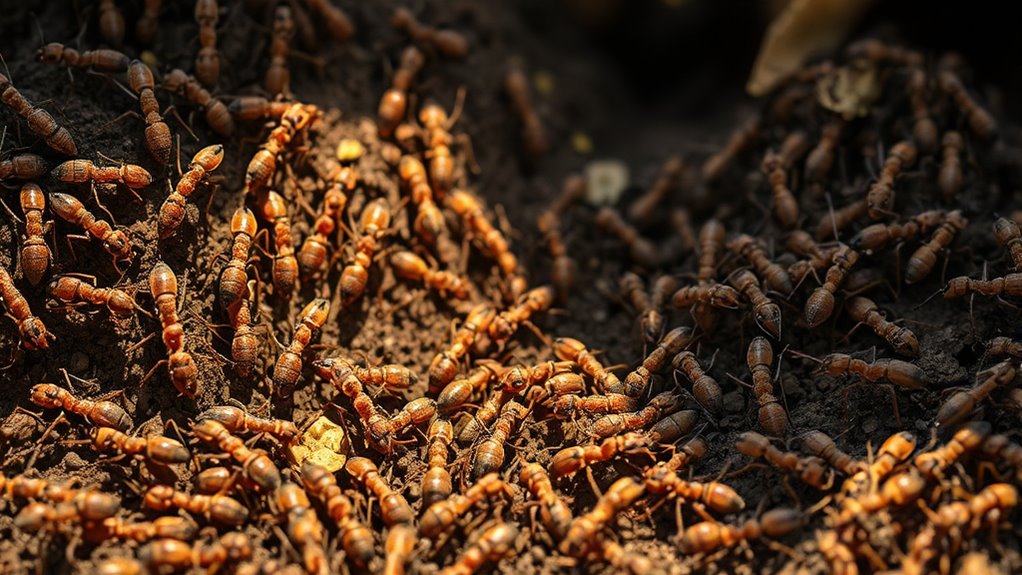
In ant colonies, each member has a clear role that boosts the team's overall effectiveness.
When every ant knows its responsibilities, it fosters accountability and a shared purpose, allowing the colony to thrive.
Understanding this structure can help you appreciate how teamwork functions in both nature and human endeavors.
Clarity Enhances Team Effectiveness
When you look at the inner workings of an ant colony, it's clear that defined roles are essential for effective teamwork. Ants can teach us that clarity enhances team effectiveness by ensuring each member knows their specific tasks, whether they're workers, soldiers, or the queen.
This division of labor allows for seamless collaboration, as ants rely on one another to fulfill their responsibilities without overlap or confusion. Each ant's understanding of how their role contributes to the colony's overall success boosts productivity and leads to remarkable achievements.
Research shows that colonies with clearly defined roles consistently outperform others, demonstrating the power of teamwork driven by clarity. In fact, the benefits of choosing this lesson can greatly improve how you approach teamwork in your own life.
Role-Based Accountability
While observing the dynamics of an ant colony, you can't help but notice how defined roles foster accountability and drive teamwork. Each ant knows its purpose, creating a well-oiled machine.
Here's why role-based accountability is essential:
- Enhanced Efficiency: Worker ants focus on specific tasks like food collection and tunneling, ensuring nothing falls through the cracks.
- Stronger Collaboration: Sisters work side by side, driven by their defined responsibilities, creating a bond that strengthens the colony.
- Shared Success: Every role, from soldier to queen, is critical, reinforcing that each ant contributes markedly to the colony's overall success.
Role-based accountability not only promotes effective operation but also instills pride in every member, reminding us all that no role is insignificant.
Collective Purpose and Vision
Defined roles within an ant colony not only clarify individual responsibilities but also cultivate a shared purpose that drives teamwork.
Each ant, whether a worker, soldier, or queen, plays an essential part in achieving the colony's collective purpose. Worker ants focus on foraging, nurturing the young, and protecting the nest, ensuring that every task aligns with the colony's goals.
The queen, laying up to 30,000 eggs daily, embodies leadership, maintaining a unified vision for growth.
Communication through pheromones helps coordinate efforts, reinforcing the importance of interdependence. This structure empowers each ant to contribute to extraordinary feats, illustrating how defined roles enhance effectiveness and foster a strong sense of belonging within the colony.
Communication Strategies Among Ants
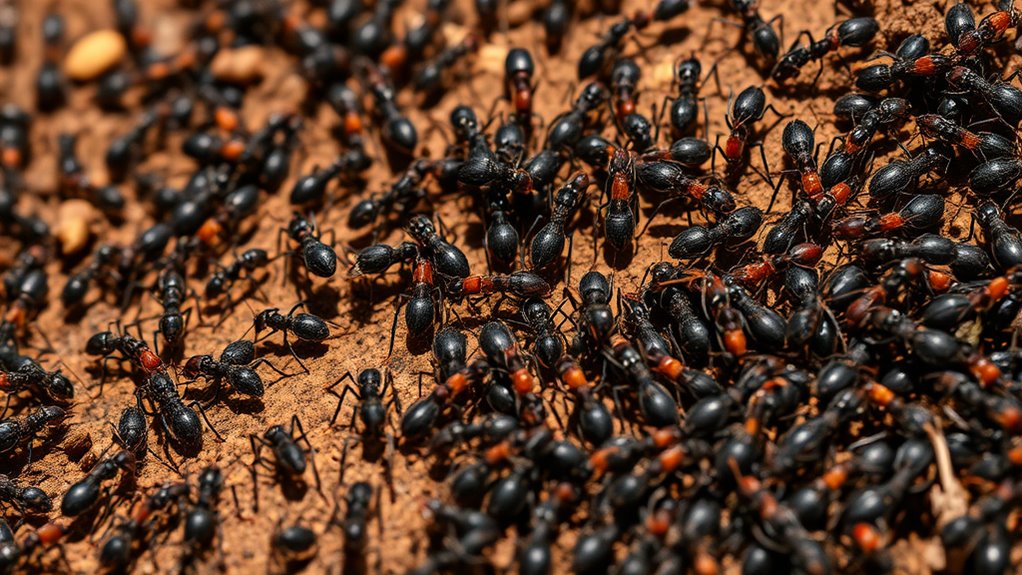
When you observe ants, you'll notice how they use pheromone trails to lead others to food and significant spots in their colony.
You might also hear them produce sounds, like stridulation, to signal danger or coordinate their tasks.
These communication strategies play a vital role in their teamwork and efficiency.
Pheromone Trails
Ants excel at communication, primarily through their intricate pheromone trails. These chemical signals are essential for guiding fellow ants to food and warning them of dangers.
When a worker ant finds food, it expertly lays down a pheromone trail back to the nest, enabling others to follow. The efficiency of this system is truly remarkable:
- Food Discovery: A strong pheromone trail leads to abundant resources, rallying the colony.
- Danger Alerts: Quick pheromone signals can save lives, ensuring safety.
- Team Coordination: Ants adjust pheromone intensity based on resource quality, optimizing teamwork.
This sophisticated use of pheromone trails not only exemplifies their communication skills but also showcases the incredible organization within an ant colony.
Sound Communication
In addition to their impressive pheromone communication, many ant species harness sound signals to convey important information. This sound communication, often through a technique called stridulation, allows ants to alert their fellow colony members to dangers or other urgent situations.
By rubbing their body parts together, ants create vibrations that transmit messages, enhancing their teamwork. While pheromones guide ants to food and signal threats through varying concentrations, sound adds another layer to their complex communication system.
This dual approach guarantees that ants can respond quickly and effectively to challenges, maintaining colony cohesion and coordination. Ultimately, sound communication complements pheromone trails, enabling ants to work together seamlessly in various tasks, from foraging to defending their home.
Strength and Resilience in Ant Behavior
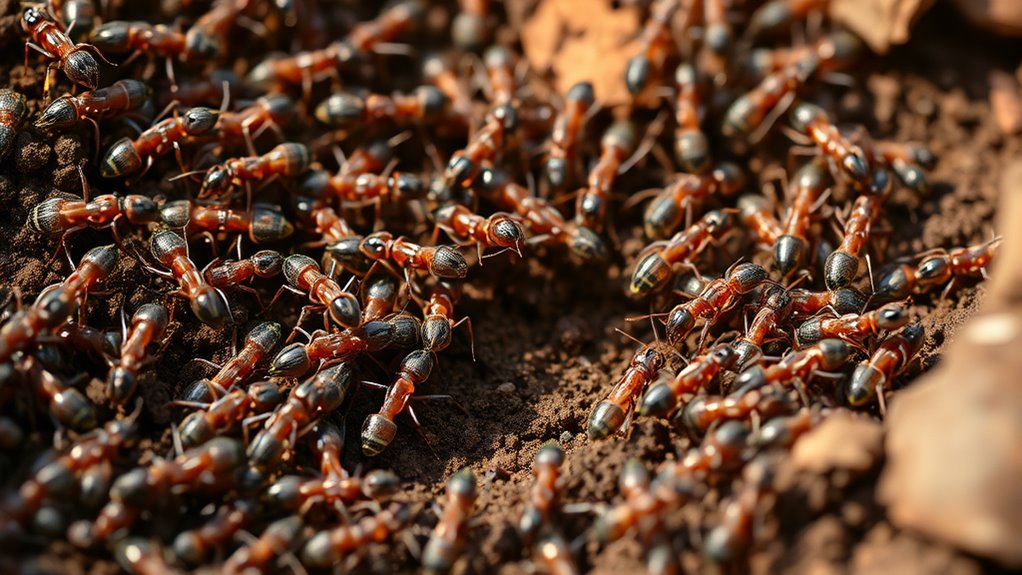
Although often underestimated, the strength and resilience of ants are truly remarkable. These tiny creatures showcase their incredible abilities when they work together, achieving feats that seem impossible.
Consider these striking facts:
- Ants can carry loads up to 50 times their body weight, demonstrating unmatched physical strength.
- The queen ant lays about 30,000 eggs daily, ensuring the colony's future and resilience.
- When faced with adversity, ants collectively exhibit emotional resilience, fostering determination within the colony.
This combination of physical prowess and unwavering teamwork allows ants to adapt and thrive in changing environments.
Their collaborative spirit not only enhances their survival but also highlights the power of unity in overcoming challenges. You can't help but admire their dedication!
Planning and Adaptability in Ant Societies
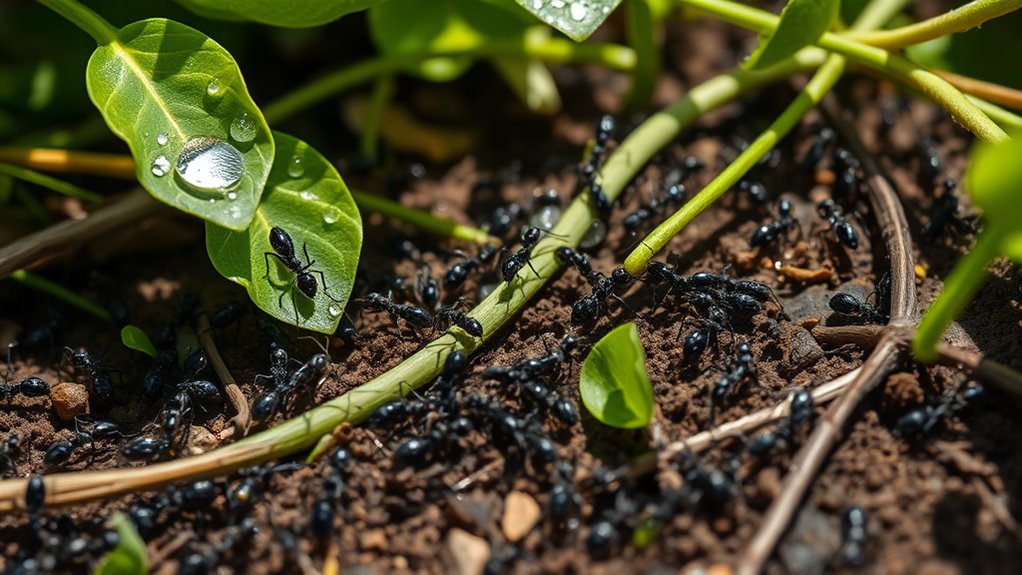
When faced with environmental changes, ant colonies showcase extraordinary planning and adaptability that secure their survival. These meticulous planners adjust their strategies based on the situation, demonstrating remarkable resilience. Ants communicate effectively, allowing them to coordinate efforts seamlessly, guaranteeing they can tackle threats or resource shortages quickly.
| Trait | Description | Importance |
|---|---|---|
| Planning | Strategies evolve with changing needs | Secures survival |
| Adaptability | Quick response to threats | Enhances resilience |
| Role Flexibility | Individuals shift responsibilities | Meets colony demands |
Through these traits, ants exemplify how structured planning and adaptability work hand-in-hand, enabling them to achieve common goals and thrive in diverse environments.
Leadership Dynamics Within Ant Colonies
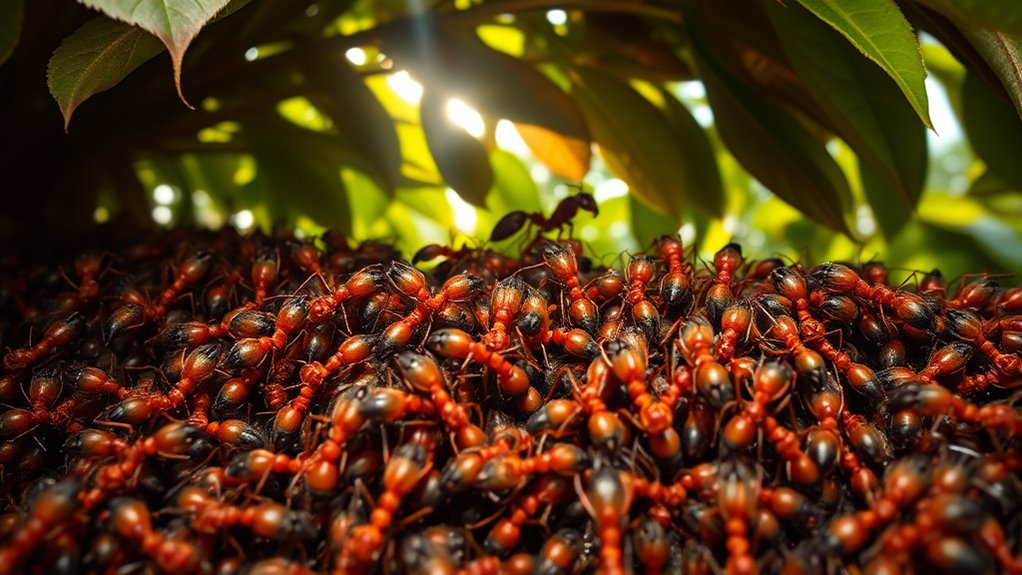
Leadership dynamics within ant colonies reveal a fascinating interplay of roles that guarantees the colony's success. The queen ant leads reproductive efforts, but the real magic lies in shared leadership. Each ant knows its role, contributing to the colony's resilience.
Ant colonies exemplify shared leadership, where every ant's role strengthens the collective resilience and success of the community.
- Communication: Ants use pheromones and sounds to share essential information, ensuring everyone is aware of resources and threats.
- Adaptability: When challenges arise, roles shift seamlessly, showcasing the colony's ability to reorganize and thrive.
- Cooperation: From workers to soldiers, each role emphasizes teamwork, proving that interdependence is fundamental for survival.
In this dynamic environment, leadership isn't just about hierarchy; it's about collaboration and the shared commitment to the colony's well-being.
Lessons on Collaboration From Ants

Ants offer remarkable lessons on collaboration that can inspire us in our own teamwork efforts. In their colony, each ant has a specific role—workers, soldiers, and drones—contributing to the group's overall success. This clear division of labor guarantees that every task is handled efficiently.
Communication among ants is vital; they use pheromone trails to lead each other to food sources, showcasing effective resource management. Their mutual interdependence highlights how success often relies on collective effort.
Furthermore, ants adapt their strategies based on environmental changes, demonstrating the importance of flexibility in teamwork. The incredible achievements of ant colonies, from building nests to forming living bridges, remind us that remarkable results stem from cooperation and shared goals.
The Impact of Ants on Ecosystems and Human Insights
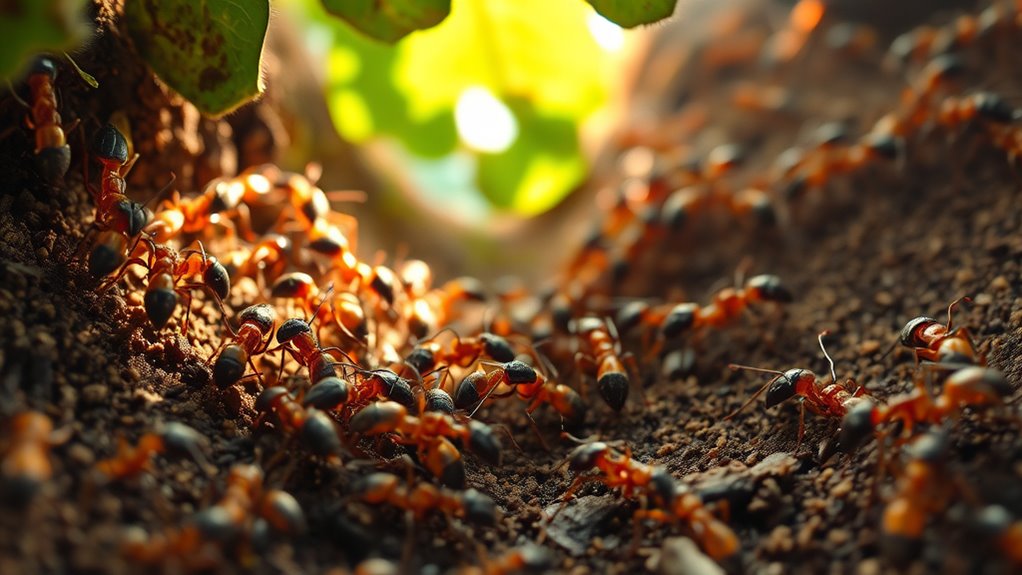
The remarkable teamwork observed in ant colonies extends beyond their immediate environment, greatly influencing ecosystems and offering valuable insights for human endeavors.
By working together, ants contribute significantly in several ways:
- Soil Aeration: They enhance water infiltration, promoting plant growth and supporting biodiversity.
- Natural Pest Control: Ants prey on various insects, reducing the need for harmful chemical pesticides in agriculture.
- Nutrient Cycling: They break down organic matter, enriching the soil and fostering healthy ecosystems.
With an estimated global population of 20 quadrillion, ants highlight the power of collaboration. Their collective behavior inspires us to tackle complex problems together, encouraging efficient resource management and innovative solutions across diverse industries.
Embracing this teamwork can lead to sustainable practices that benefit both nature and humanity.
Frequently Asked Questions
How Do Ant Colonies Work Together?
When you observe how ant colonies work together, you'll notice their remarkable organization. They divide tasks among themselves, assigning roles to guarantee efficiency.
Communication plays a key role; they use pheromones to guide each other to resources and coordinate efforts. You'll see them cooperating to build nests and care for their young, adapting their strategies as needed.
Their ability to lift heavy objects together showcases the strength of their teamwork, making impossible tasks achievable.
What Is the Team Work of Ants Colony?
Ants' astonishing ability to achieve amazing accomplishments stems from their superb teamwork.
You'd notice how they communicate effectively, coordinating their efforts through pheromones to find food or protect their home. Each ant has a specific role, whether foraging for sustenance or caring for young, which boosts their collective success.
Their impressive interdependence and collaborative spirit not only guarantee survival but also highlight the power of unity in nature's intricate web of life.
How Do Ants Show Teamwork?
Ants show teamwork in various impressive ways. They communicate using pheromones to guide each other to food and important locations.
You'll notice how they divide tasks among themselves, with some acting as workers or soldiers. When building nests or forming bridges, they collaborate seamlessly, using their combined strength to navigate obstacles.
Their ability to carry loads many times their weight demonstrates how much they accomplish together, far exceeding individual efforts.
What Team Secret Do You Learn From Ants?
You'll discover that the secret of teamwork is like a well-tuned orchestra; every member plays an essential role.
Ants teach you the value of clear communication and mutual support. When you embrace flexibility and adapt to challenges, your team can achieve extraordinary feats.
Remember, collaboration isn't just about the strength of individuals, but the power of unity.
Conclusion
In the intricate dance of ant colonies, you see a masterclass in teamwork that humbles even the most seasoned leaders. These tiny architects of nature teach us that defined roles and effective communication can build a resilient community. Just like ants, when you embrace collaboration and adaptability, you can overcome any challenge. So, let their teamwork inspire you—after all, even the smallest creatures can create a world of impact, one tiny step at a time.
